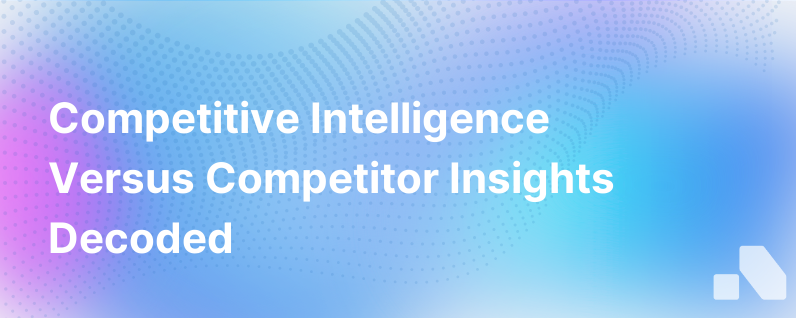
In the world of business, knowledge truly is power. To maintain a competitive edge, decision-makers must constantly stay on top of evolving market conditions. This involves extensive research, analysis, and strategic planning. Competitive and competitor intelligence provide the necessary insights to make informed and effective decisions.
While these terms may seem similar, they cover different aspects of market analysis. This article will demystify the difference between competitive intelligence and competitor intelligence and discuss their crucial roles in business strategy.
Understanding Competitive Intelligence
Competitive intelligence is essentially about understanding everything beyond your organization's boundaries. This includes market trends, technological developments, regulative changes, and political shifts—everything that can shape your business environment.
Competitive intelligence provides a holistic view of your industry and market. It prepares you for changes in buyer behavior, opportunities for new partnerships, and threats from market disruptors.
Some key benefits of competitive intelligence include:
- Insight into Market Trends: Recognizing emerging patterns and predicting future market trends can help your business stay ahead and capitalize on opportunities.
- Understanding Customer Needs: By surveying the market, you can gain insights on shifting customer needs and preferences.
- Risk Management: An awareness of regulatory changes and political shifts can help your business prepare for and mitigate risks before they become crises.
- Guided Strategic Decision-Making: Evidence-based competitive intelligence can guide strategic decision-making, improving the likelihood of achieving business goals and objectives.
Understanding Competitor Intelligence
Competitor intelligence focuses specifically on your industry rivals. It involves collecting, analyzing, and interpreting data about your competitors and their activities. Competitor intelligence allows organizations to anticipate their competitors’ next moves, potential threats, and opportunities.
Some core benefits of competitor intelligence include:
- Identifying Competitive Advantage: With thorough competitor analysis, you can identify your unique selling propositions (USPs) and emphasize these in your marketing and sales strategies.
- Predicting Competitor Moves: The analysis can unearth patterns in your competitors’ behavior, allowing you to anticipate and counteract their strategies effectively.
- Improving Product Development: Detailed analysis of competitors’ products and services can inspire improvements in your own products or unveiling of new offerings.
Interplay of Competitive Intelligence and Competitor Intelligence
Although competitive and competitor intelligence are distinct fields, they are undeniably interconnected. The real magic happens when you can integrate the insights derived from both.
Your understanding of the broader competitive landscape (competitive intelligence) can inform your tactical moves against specific competitors (competitor intelligence). Similarly, a deeper understanding of your competitors' strategies and tactics can orient where you look for broader market and trend insights.
For instance, learning from competitive intelligence that a new technology is disrupting your industry could drive you to investigate how your direct competitors are responding to this change—knitting together the insights from both fields.
Conducting Competitive and Competitor Intelligence
Putting a system in place to gather and analyze competitive and competitor intelligence can seem arduous. Earlier, it would involve lots of manual tasks, but today, artificial intelligence platforms like Aomni have simplified the process.
Aomni's AI-powered platform automates competitive and competitor intelligence, equipping businesses with real-time account research, actionable insights, and personalized sales content. With Aomni, you can turn around precise intelligence in as little as 15 minutes, with zero effort required.
AI platforms democratize access to vital business intelligence, empowering a broad cross-section of departments. From marketing to product development to customer service—organizations can now make data-backed decisions in less time with better results.
Conclusion
Navigating the fiercely competitive B2B landscape requires businesses to be proactive and well-informed. Both competitive intelligence and competitor intelligence play crucial roles in shaping strategic decisions and actions.
Combining these two pillars of intelligence provides your business with a comprehensive, 360-degree view of your industry, market, and competitive landscape.
By integrating AI platforms like Aomni, you can automate the process of gathering, analyzing, and acting upon competitive and competitor intelligence. This empowers faster, data-backed decisions, advancing your business towards sustained growth and success.